The Flight of the Ladybugs
by Cat Ferguson

Every winter, ladybugs coat trees and hillsides in the Sierra Nevada mountains with bright orange scales. Each aggregation can contain millions of the insects, hunkered down in a kind of seasonal dormancy called diapause, and every year, collectors head out with snow shovels, nets, and bags to scoop them up by the millions. The beetles are sold to wholesalers, who offload the haul to farmers and gardeners as a living insecticide. This year, though, Arbico and Natural Pest Controls, two major wholesale suppliers of ladybugs, ran into a problem: there weren’t enough ladybugs to collect.
Both companies blame California’s severe drought and ongoing wildfires. According to one of Arbico’s sustainable agriculture specialists, Arianna Weisbly, wildfires have ravaged the ladybugs’ spring feeding grounds, while hot weather and drought have prevented them from entering diapause. “Global warming and human input (I’d wager most of the wildfires are human caused) have basically halted our collection,” she wrote in an email. But there’s another, less studied possibility: that unabated mass collection has thinned the Sierra Nevada population of convergent lady beetles. “No one ever looked to see if collecting hundreds of millions of lady beetles from the Sierras each year was sustainable,” Scott Black, executive director of the Xerces Society, a non-profit dedicated to invertebrate conservation, told me. In fact, no one is studying the population at all, so it’s impossible to tell how many ladybugs are gone — or why.
The Lost Ladybug Project, a citizen science program that tracks ladybug populations around the country, has noted for years that populations of many lady beetle species have been shrinking or moving around — the result of an unknown number of variables. For instance, between ten and fifteen percent of wild ladybugs carry deadly parasites, which may spread when animals are relocated for agricultural use or otherwise change locations. Some species also face competition from the Asian lady beetle, which was originally imported to control soybean aphids; it not only outcompetes the locals for food, it carries a deadly fungus.
According to Leslie Allee of the Lost Ladybug Project, losses of ladybug populations have the potential to increase the use of chemical pesticides, since even non-organic farms rely on the spotted bugs to keep pest populations down. “Ladybugs are part of complex food webs,” Allee wrote in an email. “A reduction in ladybug numbers could result in a surge of aphids and other soft bodied insects, and this, in turn, could affect other parts of the web and result in reductions in plant health or plant survival in certain areas.”
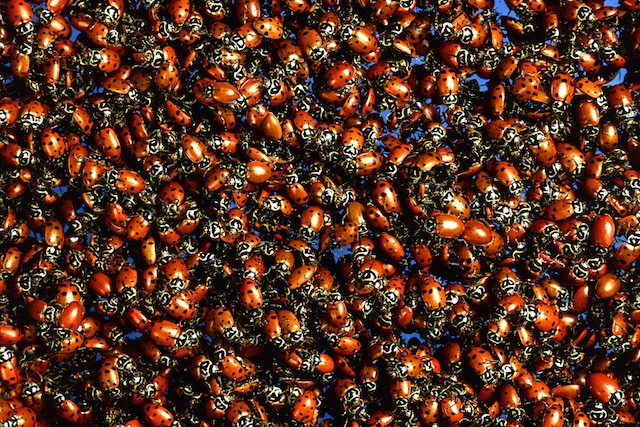
Each ladybug species has a specific feeding preference, but generally they eat aphids, tiny green dots that decimate food crops and ornamental plants. “Aphids will go after just about anything they can get their little mouths on,” Brian Morris, the head of horticulture for the Central Park Conservancy, which buys and releases ladybugs into the park every summer, told me. That includes roses, corn, peas, cotton, potatoes, and cabbage. On top of their versatile appetites, aphids breed fast, and in large numbers. “Aphid are born pregnant. They’re like Russian dolls,” Morris said. Other animals eat aphids, including lacewings, wasps, and praying mantises, but lady beetles, as ladybugs are technically known, are a favorite among farmers and gardeners because they’re cheap, ravenous and charismatic. From the moment they hatch, they prey on aphids with a voraciousness hardly suggested by our screensavers and desktop backgrounds. “If you’re an aphid, that’s the scariest predator in town,” John Trumble, an entomologist at UC Riverside, told me.

So, instead of using chemical pesticides, many farmers and gardeners have come to rely on convergent lady beetles as a “natural” solution. (The most common agriculture pesticides deployed against aphids are organophosphates, which are acutely toxic to humans and implicated in colony collapse disorder in bees. The chemicals are nerve agents, dispatching animals of all sizes in brutal, twitching deaths.) One farmer in Washington state, who asked not to be identified, released two gallons of ladybugs across a hundred acres of peas in July — around twelve hundred ladybugs per acre. “I like the thought of using them from the standpoint of less chemicals, less harm to pollinators and other beneficial insects,” he said.
Unfortunately, there’s a century of evidence that moving ladybugs around the country isn’t as effective as conventional pesticides at suppressing aphid populations. On waking from their winter slumber, the ladybugs are naturally inclined to have a snack and then fly off to warmer digs within a few days. “There’s tons of information that these are collected when they’re in the mountains, and when they wake up from hibernation they’re predisposed to fly. Basically, you release them in your yard and they fly three, ten, forty miles, and they’re in somebody else’s yard doing pest control,” Black said. He suggests growing plants that will naturally attract ladybugs, instead of importing them.
Farmers who do release ladybugs will probably lose around ninety percent of their flying workforce within a week. A 1919 California State Commission of Horticulture bulletin noted: “After three days, fewer and fewer beetles could be recovered, and at the end of a week hardly a beetle was visible even if abundant food was present. Moreover, counts made in other parts of the field indicated that but a small percentage, rarely estimated as over 10 per cent, had remained in and dispersed themselves over the field.” The Washington farmer reported similar results in 2014. “I do not believe a lot of them stayed,” he said. “The aphid population we had was incredible. They should have had plenty to feed on,” the farmer said. He said he’d be happy to try again next year, though, with even more ladybugs.
Some gardeners recommend spraying the ladybugs with a sugar solution, to glue their wings shut, to keep them around for longer. But rather than forcing adults to stay, Morris thinks it’s a better idea to rely on the ladybugs’ offspring. “It’s not so much the adults we release that control the aphids. It’s primarily their progeny, the larvae that hatch the following year, that really do the job,” Morris said of the Central Park releases. “They look nothing like ladybugs — they’re a little scary looking.” A female can lay up to five hundred eggs, and each baby eats around fifty aphids a day. Morris believes that ladybugs lay eggs before decamping, though scientists have not confirmed this.
Assuming there are enough ladybugs left to capture, the practice will probably continue. “You can buy ladybugs that have been grown in a nursery, but it’s much more expensive” and not very common, Trumble said. It’s much easier to just scoop up wild beetles while they’re in diapause, regardless of the consequences. “If the population starts to bounce back, are collectors going to get right back out there to collect them?” Black asked. “I think we should curb this practice until we know what the overall impacts are.”
Cat Ferguson is writer with a dog and an email address.
Photos by Oliveoligarchy, USDA, and scyrene, respectively
Shabazz Palaces, "#CAKE"
Here is Shabazz Palaces with its first full video from Lese Majesty. The group, like this song, is all sharp edges and extreme angles — the album’s tracks often don’t take shape until halfway through, which is exhilarating and disorienting. In “#CAKE,” Catherine Harris-White shows up about a minute and half in, starts to give us something we can hold on to, then recedes into the chaotic background again.
Don't Meat the Eggplant

Most summer produce has a cult of worship; there are those who wait all year for the few weeks of tomato season, those who will serve fresh corn with every meal, those who will gorge on peaches until the sweet-tart juice carves furrows into their faces like Grand Canyon erosion writ small. But there is one item which rarely if ever inspires devotion. I’m speaking here of the noble eggplant.
Many people do not like eggplant. Common complaints are that it is spongy, or bitter, or mushy. All of these are symptoms of improper cooking. Because, friends, when eggplant is cooked properly it can achieve something few other fruits or vegetables (it is technically a fruit) can: It is DECADENT. It is INDULGENT. It is LUXURIOUS. And, frankly, it is NOT PARTICULARLY HEALTHY. These are all good things, I think!
Eggplant is often used as a meat substitute; a typical description, this one from Prevention, says, “Grilled or sauteed briefly, eggplant has a firm, almost meaty texture.” NEVER DO THIS. This is the equivalent of saying oxtail or pig’s feet or brisket has a “firm texture” when cooked briefly. Sure, it’ll technically be “firm,” but those ingredients aren’t supposed to have a firm texture. In fact, despite what you might see all over Pinterest, do not, under any circumstances, place slices of lightly oiled eggplant on the grill; a grill tends to dry out an oiled eggplant rather than confit-ing it the way a roasting pan does, and eggplants are sort of gross and very difficult to eat when they have a firm texture. Mark Bittman, in an otherwise excellent defense of eggplant, grudgingly gives advice for achieving an “ultra-firm (O.K., meaty) texture.” I will not repeat his advice nor give my own to achieve this. (But! You can, as Bittman recommends, prop the whole eggplant right up against the coals in the coldest part of your grill and allow the skin to burn and blister. Then peel the eggplant and blend/mash with olive oil and roasted garlic.) The eggplant is not a zucchini. They must be cooked low and slow, breaking down all the fibers until the insides become fatty and creamy and delicious, and the outsides crispy and oily.
Eggplant, like oxtail or brisket, is not a healthy food. Eggplant is low in protein, low in carbohydrates, and basically bereft of beneficial vitamins and nutrients. (Weirdly, it does have more nicotine than any other fruit or vegetable. Not a LOT — something like twenty pounds of eggplant equals one cigarette’s worth of nicotine. But still!) It is a junk food, to be ceremonially cooked and eaten with eyes closed, and then to make the eater feel guilty afterwards. This is a rare treat for vegetarians; it can be hard to indulge when all you eat is vegetables.
Proper ways to cook an eggplant include slow roasting, slow baking, frying (if very thin slices), and stewing. Regardless of method, the ideal texture is buttery and creamy. The eggplant should be cooked with something it can absorb, whether that is oil or stew liquid (tomatoes, for example, in a ratatouille), and it should absorb as much of this liquid as possible. You know how some vegetables like potatoes are done when you can easily pierce them with a fork? Eggplant is done when you pierce it with a fork and aren’t sure you actually pierced it because the eggplant offers no resistance whatsoever.
But this should not imply eggplant is difficult to cook! A common instruction calls for the salting of eggplant slices placed in a colander. Fuck this! Don’t bother! I have tried it many times and, except with the toughest, bitterest eggplants (those little globular Thai ones), it makes no difference whatsoever. Skip that step.
The most basic recipe is also one of the most delicious: slice any variety of eggplant into half-inch rounds (with the skin on, always), toss in more oil than you think you need along with salt and spices (curry powder mixes work well, as does cumin and turmeric, or za’atar mix, or dried herbs like thyme and oregano), place on baking sheet, pour more oil on top, and roast at 350 degrees until soft. No other steps! Eat!
And now that Labor Day is coming up, the official end of summer (boo! hiss!), it is a great time to celebrate summer’s most underrated vegetable (or fruit, whatever). A great summer dish is the Israeli classic fried eggplant: slice eggplant thinly, fry in about a quarter-inch of oil, flipping halfway through, until browned and soft. Serve on a plate with chopped mint, salt, and, if you want, some crushed red pepper flakes, and a squeeze of lemon over top. It isn’t “meaty” in the usual sense of the word; there is no meat on Earth with the texture of well-fried eggplant. But there aren’t too many things tastier, either.
Crop Chef is an occasional column about the correct ways to prepare and consume plant matter, by Dan Nosowitz, a freelance human who lives in Brooklyn.
Photo by Brian (Ziggy) Liloia
The Fall of the Humanities and the Tyranny of Recommendation Letters: A Novel and a Chat
by Jessica Gross and Merve Emre

Dear Committee Members is the second novel from PEN/Hemingway award finalist and creative writing professor Julie Schumacher. Written entirely in the form of letters of recommendation, the novel relays the academic trials and tribulations of Jason Fitger, a floundering novelist, creative writing professor and self-proclaimed “dinosaur” in the rapidly changing landscape of liberal arts education. At a time when literature departments are in danger of extinction and bureaucrats wield unprecedented power over university funds, Fitger aspires to speak truth to power through his rambling, disjointed, and cranky letters of recommendation. The best use for these letters, he believes, is not to praise his misguided students and colleagues but to show his readers just how broken our system of higher education really is. Dear Committee Members is a novel propelled by Fitger’s relentless frustration.
Reader, we read it. And now we’re here to talk about it.
Merve Emre: Jess, in January, Julie Schumacher wrote a piece in The Chronicle of Higher Education in which she bemoaned the letter of recommendation — heretofore, the LOR. “Most letters of reference, as pieces of writing, are awfully dull,” she complained, and proceeded to explain why. They’re repetitive. They’re overly enthusiastic — suspiciously so. They’re impossible to distinguish from one another. They leave their readers exhausted, annoyed, and bleary-eyed, or entangle them in ugly calculations of institutional prestige. (What “counts” for more? A letter from an adjunct professor at an Ivy League or the chair of a third-tier English department?) Given Schumacher’s antipathy towards the genre and its conventions, it seems like she’s set a very high bar for herself in structuring an entire novel around the very form she decries.
Jessica Gross: Yes, she has. Several themes emerge early in the book and are hit upon repeatedly in the letters that follow. There’s the explicit theme of detesting writing LORs — Fitger echoes Schumacher’s concerns here, sometimes in the same language she used in the Chronicle piece. Here she is in the piece: “Evidence of the letter-of-rec’s increasing absurdity: While serving on award committees here at Minnesota, I have on more than one occasion opened an e-file and discovered that — in lauding a student or a colleague — I had written a letter to myself.” And in the novel, as Fitger: “The LOR has become a rampant absurdity, usurping the place of the quick consultation and the two-minute phone call…On multiple occasions, serving on awards committees, I was actually required to write LORs myself.”
The LORs allow Fitger to lament the underfunding and general lack of support for the humanities and the comparative favoritism toward the social and hard sciences (in this book, the favorite-child scapegoat becomes economics). The fictional Payne University’s English department is under construction, and the poor professors have to work there anyway: “we are living in a Brave New Department, in a building half of which has been cordoned off with tape as a hazardous zone.” There’s the dwindling respect for the importance of the arts, in general. Schumacher hits each of these themes over and over again in her letters, which at once successfully mimics the repetitiveness of LORs — Fitger is, after all, conveying these concerns to different people each time — and becomes quite tiresome. Toward the end of the book, I started writing margin notes like, “We get it!” How’d it work for you?
ME: On the one hand, I appreciate and admire the formal limitations Schumacher has set for herself. I enjoy novels that experiment with narrative structure, particularly ones that co-opt the structure of whatever it is they’re critiquing — in this case, the slow and costly metastasis of administrative bureaucracies in higher education — for some kind of aesthetic project. But when the form you’ve chosen for your novel is — by your own account — vacuous, dull, and encourages readers to skim, skip, or abandon reading altogether, there needs to be some kind of counterbalance to the genre’s constraints.
For me, neither the prose nor the character development of the narrator, Jason Fitger, really counteracts the novel’s flatness; its repetitive patterns ultimately hollow out first its satire, then its claims to realism. There is the “incessant dripping” from a burst pipe whose splashes underscore the English Department’s sad, soggy situation. There is a “blue mailbox…emphatic in the new-fallen snow” with a “quaint rectangular mouth” where Fitger routinely deposits his letters so as to eschew the impersonality of email forms. And, of course, there are the stingy department chairs, the lecherous tenured faculty, and the technocracy’s “unsocialized clones,” all of who are made to account for their sins at the end of each letter.
I, for one, have never found the shrill rhetoric of the current “crisis in the humanities” historically accurate or emotionally persuasive. (Disclaimer: If you like Rebecca Schuman’s writing, you will probably like this book.) Nor do I find much depth in Fitger’s ethical pleas throughout the novel for how “the reading and writing of fiction both requires and instills empathy.” By putting these words in Fitger’s mouth, Schumacher seems to want her fiction to perform the kind of ethical work that Fitger wants to claim for fiction at large. Unfortunately, the prose simply can’t carry the weight of the novel’s ethical ambitions. (However controversial or disputed they may be.)
Like the committee members who read LORs, I found my eyes darting from paragraph to paragraph for some lovely image, some veiled warning, some scintillating gossip — something, anything to break the monotony of reading this novel.
JG: I hear you! An added difficulty is that Schumacher chose to interweave the letters to and about characters that persist throughout the novel (Fitger’s ex-wife, several people they attended Seminar with in their youth, his ex-girlfriend, and his sole graduate student) with one-off LORs about random students. If this book is simply an argument against “the never-ending battle” to fulfill LOR requests, the onslaught made sense; but as a novel, I found the constant introduction of new characters who would disappear a page later to be overwhelming and ineffective, especially since these letters simply reinforced layers of Fitger’s persona and stance that we already knew.
On a broader level, it’s challenging to have a novel entirely composed of one person’s letters, period. Often, background information included for the reader’s benefit felt awkward or forced in the context of a letter. Not to mention that this is a first-person point of view in a straitjacket. I found myself wishing repeatedly for reply letters, even as I heard the counter-cry, “Consider the book on its own terms!” It’s the kind of thing that could work if the narrator could carry it. Fitger’s character becomes more compelling in the second half of the book — he has moments of reflection about his relationships, himself, his mortality — but not enough to carry the novel.
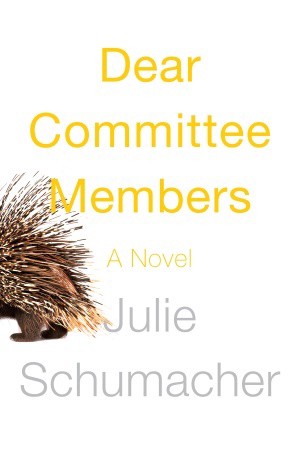
ME: It raises the question: what does it take to be compelled by a narrator who you find unreliable, unlikeable, or morally questionable? This question has often haunted the (mostly male) narrators of campus novel, from Humbert Humbert in Lolita to the unnamed narrator in Randall Jarrell’s Pictures from an Institution to William Henry Devereaux Jr. in Straight Man. Schumacher certainly does not trade in the “fancy prose style” that enables a narrator like Humbert Humbert to seduce us. (Jess, you already pointed out that her prose style reads like a barely exaggerated version of her letter to the Chronicle.) And her satire lacks the subtlety to be truly, incisively funny. (One of the running gags in the novel is that Fitger signs his letters with such ludicrous titles as “Jay Fitger, Winner’s Circle.”) Lucky Jim, Trading Places, Groves of Acadame, and Wonder Boys are all campus novels I’d tap as sharper, wittier predecessors to Dear Committee Members.
Perhaps the most intriguing parts of the novel for me were the descriptions of other people’s books embedded in Fitger’s LORs. His troubled protégée, Darren Browles, is rewriting Herman Melville’s short story “Bartleby the Scrivener” as a novel, one that takes place in a Vegas brothel. (Mat Johnson could write this book and it would be brilliant.) Another student of Fitger’s, the much-maligned Vivian Zelles, lands a six-figure book deal for a fictionalized memoir, in which a young woman metamorphoses into a cheetah and, in a fit of rage, eats and excretes her little brother whole. Finally, an experimental novel written by a friend of Fitger’s from his days in an Iowa-style writing workshop gets rave reviews from William Gass in The New York Review of Books. Now, that’s a book I want to read.
JG: Ha! I can’t say I’m drawn to the cheetah/cannibalization narrative, but hey. To your first point: amen. I found myself irritated that I had to hang out with Fitger for the duration of the novel — which, of course, brought to mind last year’s debate about “likeable” characters in the wake of Claire Messud’s Publisher’s Weekly interview. I wondered if I just didn’t like Fitger. If so, was that some failing on my part — a desire, as Messud and many others have railed against, for a character I’d want to befriend? Or was it really a desire for a character compelling enough that I felt invested in what happened to him, i.e., I cared whether he lived or died? (Hard to feel invested in a character’s larger ethical project if you’re not invested in his individual fate.) I wonder whether the conversation about “likeability” has oversimplified this impulse, conflating a desire for well-developed characters with that for pleasant ones. Related: Rebecca Mead’s recent New Yorker piece on “the scourge of ‘relatability.’”
ME: Relatable is just a detestable word. It’s so utterly narcissistic; how does this relate to me? Why should it? And it simply doesn’t say enough about the actual quality of prose. (Dear students: please never use the word “relatable” to describe a character or book.) As for Fitger, I wouldn’t read too much into the weak feeling of “liking” or “not liking” a character, which strikes me as equally underspecified. I think it’s enough to say that Fitger is of a piece with the letters he’s writing: one-dimensional, repetitive, and banal.
JG: To come back to something we touched on earlier: this felt very much to me like a book with a mission. (Also, possibly, as wish fulfillment on the part of an author who can’t be this forthright in her own LORs.) In general, I’m very wary of a novel whose mission shines more brightly than its story. But, in truth, as a non-academic, I wouldn’t have come across Schumacher’s letter, or the issue of LORs, at all if not for this book. So, a few questions for you: Is that worth anything? And, since you’re in academia, (a) what has your experience with LORs been like, and (b) what’s your larger stance on their prevalence and on the state of support/funding for the humanities?
ME: This year, I wrote twenty LORs for many different kinds of students: students who wanted internships in finance, students seeking employment at art museums or publishing houses, students applying to graduate school and fellowship programs. It’s nowhere near as many as Schumacher writes — 50 to 100 each year, which she suggests is normal — so perhaps I have a different kind of affective relationship to the genre by virtue of the numbers alone. Which is only to say, maybe I haven’t written enough LORs to be sufficiently cynical about their purpose.
It’s a responsibility that I don’t take lightly. At times, it’s one that I have refused to take on, when I don’t think a student would be best served by my opinion of him or her. And I think, like a lot of good writing, the LOR is a genre that is best served by telling a rich, detailed story about an individual’s passion and promise. Finally, and perhaps I’m being sentimental here — I know I’m being sentimental here — but I’ve ended some letters by observing that the student in question seems to have a good heart. That should matter.
As for the humanities, there are so many other problems looming over higher education that Schumacher rightly and persistently points out. Freedom of speech, casual labor, the ballooning costs of college, a lack of diverse perspectives in education and education policy, sexual assault — the list goes on and on and on. Letters of recommendation strike me a very small issue to which to devote this much time or attention. But then again, that’s not really the point of the novel. It’s just the dissatisfying way in which it’s realized.
Merve Emre is an editor at the Los Angeles Review of Books and a doctoral candidate at Yale University. Jessica Gross is a freelance writer for The New York Times Magazine, The Paris Review Daily, and elsewhere.
Top photo by Heidi Schuyt
A Poem by Laura Eve Engel
by Mark Bibbins, Editor
Escape Hatch
Was thinking escape hatch is what I’d require.
I think escape hatch to myself in the park
and see it slink on its two good legs away
from view, leaving me with this turned-
over feeling. So long, hatch. Hello.
For a while now I’ve been hiding the news
from myself, but sometimes thoughts
try to locate the exits while I’m sleeping.
I wake to the notion of taking someone’s hands
in my hands putting on its shoes in the dark,
making its way to the door. Come back,
hands in my hands. Sometimes my thoughts
ask for gratitude and I become furious.
As far as I know, thoughts, cancer still exists,
and math, and you, like a shovel, have done
about what you can do with these things
and no better. Mostly what you’ve done is
a little light soil reorganization. My confusion
this time has to do with how routinely
we pick up handfuls of shore and toss them
into the water like we don’t know what
we’re doing. The world is full of containers
waiting to be spilled out or stepped into
like a sandbox, supported for the moment
by so many tiny plastic tractors. I hold
my phone up to the sun and it is in this way
that I live on the backs of other, loftier ideas.
Then there are geese and I point at them
as if I’ve been asked to prove it, their sounds
and that letter in the sky they swallow into.
As around everything the world is gestured at
and goes on, I’ve been made by those
distant buildings, how they face one another
and do not move, to feel like a coward.
Laura Eve Engel’s work can be found or is forthcoming in Boston Review, Crazyhorse, Tin House, and elsewhere. She is a recipient of fellowships from the Wisconsin Institute for Creative Writing and the Provincetown Fine Arts Work Center.
You will find more poems here. You may contact the editor at poems@theawl.com.
Have You Considered Your Leaders' Optics Lately?
It’s been a while since we got a good “president playing golf” story:
Unusually emotional, President Obama declared himself “heartbroken” by the brutal murder of an American journalist, James Foley, and vowed to “be relentless” against Islamic radicals threatening to kill another American.
But as soon as the cameras went off, Mr. Obama headed to his favorite golf course on Martha’s Vineyard, where he is on vacation, seemingly able to put the savagery out of his mind. He spent the rest of the afternoon on the links even as a firestorm of criticism erupted over what many saw as a callous indifference to the slaughter he had just condemned.
I don’t know, was the president’s golfing really something that “many saw as a callous indifference?” Are these “many” people actually just political pundits and their audiences of news hobbyists and partisans? Are these pundits and enthusiasts concerned with the president’s responsibility to set an example with right and proper grieving? Are they protesting on behalf of a victim’s family? Or are they actually the craven ones, for turning a gruesome death into a question of political optics (for no practical cause! not even in the service of defeating or promoting a candidate or campaign! out of pure psychopathy or nihilism!) and changing the subject so quickly, from the matter at hand to the public relations value of the manner in which the matter at hand is being handled? “Should he really be playing golf right now?” is as stupid now as it was a decade or a century ago. It imagines an appropriate presidential schedule as follows: One hour of flesh mortification, one hour of reading history, one hour of negotiating with world leaders, one hour of begging for forgiveness from citizens, repeated five times daily, televised. Before work, kiss the family for the camera. After work, go to church in public. Sleep for four hours, if necessary. Sleep is not leadership! The optics of sleep are terrible: Why does the president sleep while others are tired?
“How it looks to Americans” is a fake political question asked on behalf of impossibly gullible people who do not actually exist. “Optics” is the second worst thing to ever happen to politics, after money.
Bethany Beach, Delaware, August 20, 2014

★★★★ The little patch of ocean view lay in bands of color: clear pale blue sky, deep blue water, green grass, yellow sand. The pockets of the second swim trunks harbored old sand and old cash, washed and dried at least a year before. The low-tide waves were not choppy or obviously threatening, but they came in heavy and variable; out past the sandy churning, amid the calmer swells, a bigger one would suddenly rear up at face-smacking height. The water tasted more bitter than usual. Hours later, despite a rinse off, sand grains were still turning up in the creases of the eyelids. A tan dust on the rental car’s windshield scattered the afternoon sun. The biggest tower of the playground climber cast the only useful patch of shade on the wood chips. An osprey passed overhead and into the blinding sunlight with a glimpse of what looked like a fish, silver and floppy, in its grasp. The grill smoked, and the shadows of the miscellaneous plants in the sand around it grew long. The two-year-old, up on the deck at the rear of the house, thrust an arm and a leg through the railing, catching the light, trusting in his support. The band of sky and the band of sea were now dissolving into each other, undifferentiated blue.
The Shoemakers of Gedikpaşa
by Erich Strom
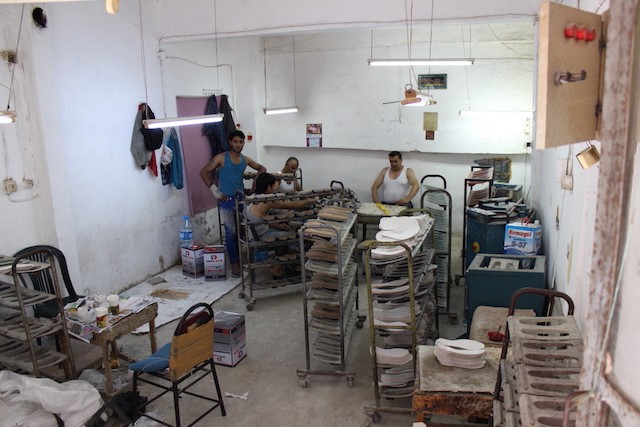
During my first days in Istanbul last month, I found myself navigating through expanses of Istanbul’s subway system so new that they did not appear in my 2013 transit map. A few days later, the country’s new bullet-train service, connecting Istanbul to Ankara, was launched by Recep Tayyip Erdoğan, the prime minister and presumed favorite in Turkey’s upcoming presidential elections, to well-orchestrated fanfare. Election campaign hyperbole aside, the country’s thriving economy and growing confidence in its future was evident in the ambitious infrastructure projects — bridges, tunnels, canals, airports — and large-scale construction that seemed to be remaking the entire city. (It was also evident in Erdoğan’s decisive victory at the polls on the other week, making him Turkey’s first directly elected president, a transition he’s deftly orchestrated over the past few years as he approached a party-imposed term limit as prime minister.)
Though the new subway lines and bullet trains — the stuff of fairy tales to a New Yorker — did provoke a certain amount of envy, other developments were all too familiar and elicited different emotions. Rising incomes have brought skyrocketing rents and gentrification across the city. Further, the political and economic stability of the past twelve years have attracted massive foreign investment and greater connection to world markets. What gentrification and globalization have done to New York’s manufacturers, and to its working-class neighborhoods, they will soon do to Istanbul’s.
One such neighborhood, seemingly out of step with the city’s race to modernize, is the old-fashioned shoemaking district along Gedikpaşa, a steep cobblestone street in the heart of Istanbul’s old city, not more than a few minutes’ walk from Topkapi Palace, the Hagia Sophia, and the other major mosques and monuments that define the tourist circuit.
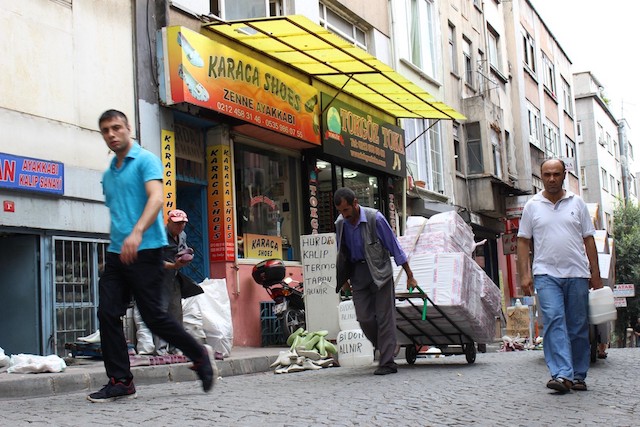
Though it faces the same fate that befell New York’s apparel industry, the shoe district of Gedikpaşa is of a somewhat different character than the Garment District sweatshops where my grandparents worked (and whose closure few mourned). Operating on a far smaller, and, to my eye, happier scale, Gedikpaşa upholds some of the traditional virtues and pleasures of neighborhood life that in recent years have been in such short supply across much of New York.
The Workshops
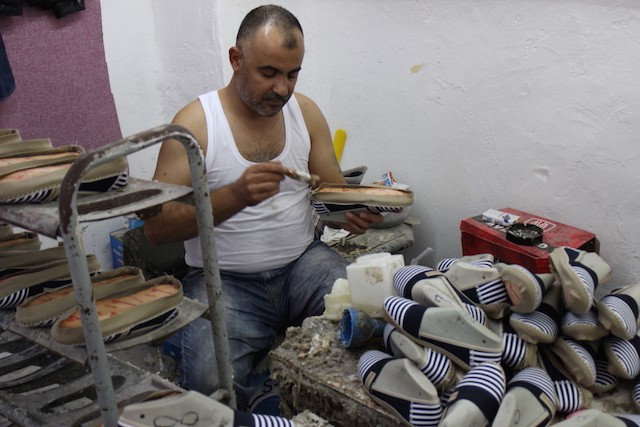
The district consisted of three overlapping but distinct zones. Toward the bottom of the hill, closest to the sea, were the workshops where the shoes were made. Typically, they were populated by three or four guys, one an apprentice, all in shirtsleeves or white tanktops, working (or not) at makeshift stations, surrounded by a welter of tools, supplies, half-made shoes, lasts, soles, and remnants.
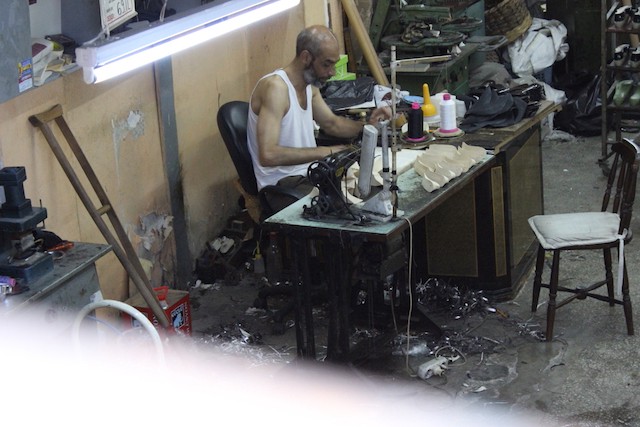
Fluorescent lights, electric fans, maybe a TV set on in the background, and a haze of cigarette smoke completed the tableau.

There were storefront workshops in residential buildings, basement workshops, cramped, old commercial buildings with multiple workshops.
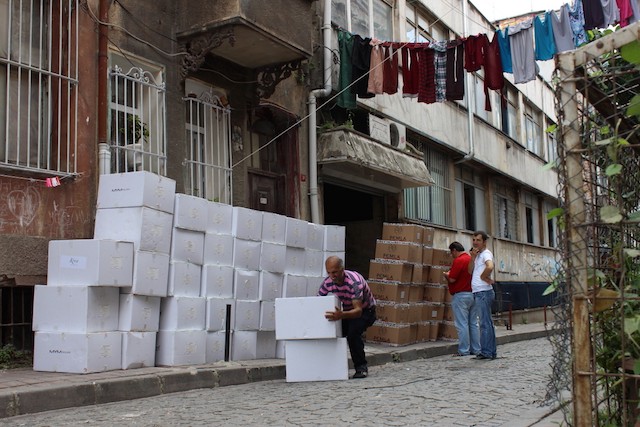
Some facilities were built along more modern lines, though these too showed the signs of extensive use and minimal upkeep. All across lower Gedikpaşa and the warren of side streets and connecting alleys, the distinctive sound of the cobbler’s hammer rang out from scores, perhaps hundreds of workshops.
The Suppliers
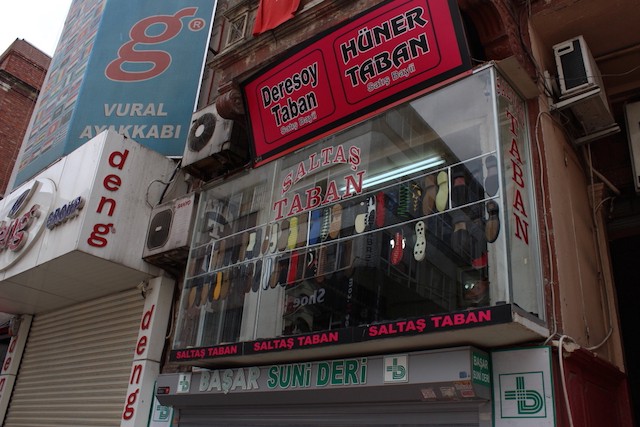
Further uphill, the workshops gave way to a network of supply stores, stocking every kind of material and tool a shoemaker might need. There were dozens of taban stores, which sold nothing but soles.
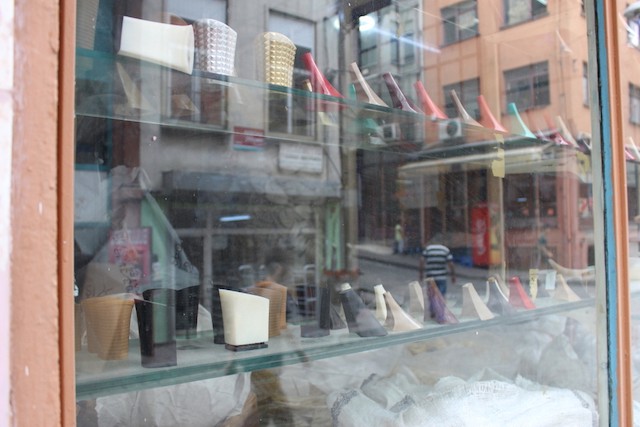
Some stores stocked heels.
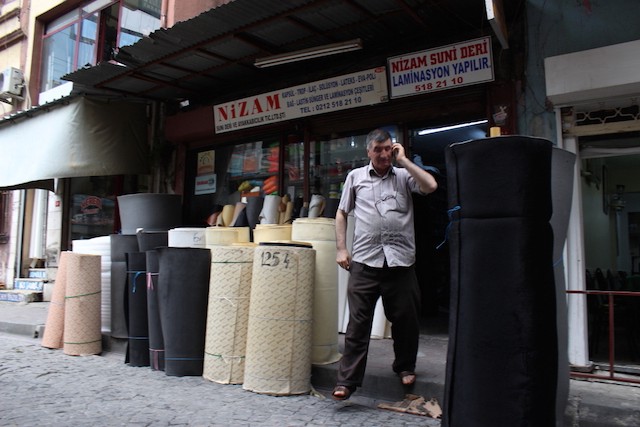
Others traded in rolls of polyurethane and polyethylene foam, for constructing midsoles and insoles.
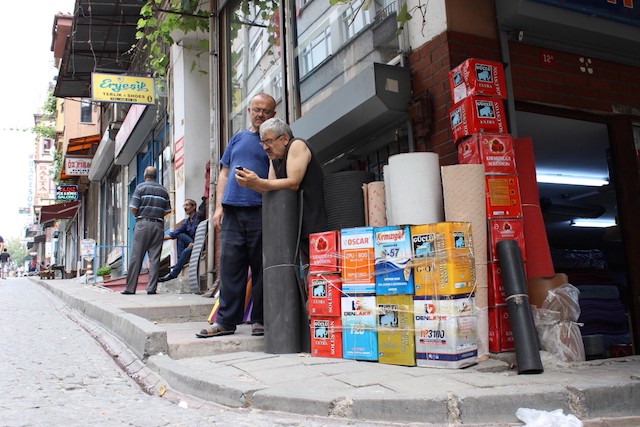
Often these dealers sold rubber cement as well. The rolls came in an assortment of thicknesses and colors, and there were various types of rubber cement, or polymer adhesives, to be more precise about it.
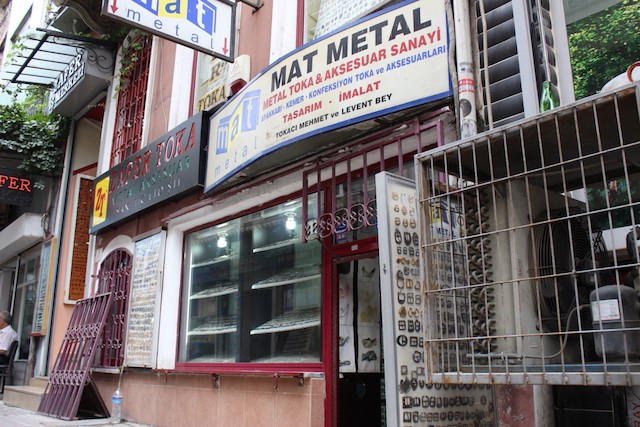
Metal shops stocked buckles, shoelace eyelets, and the like.

On one side street, I found half a dozen sewing machine shops; on another, shops that stocked awl blades, hole-punching bits, and other tools for working leather.
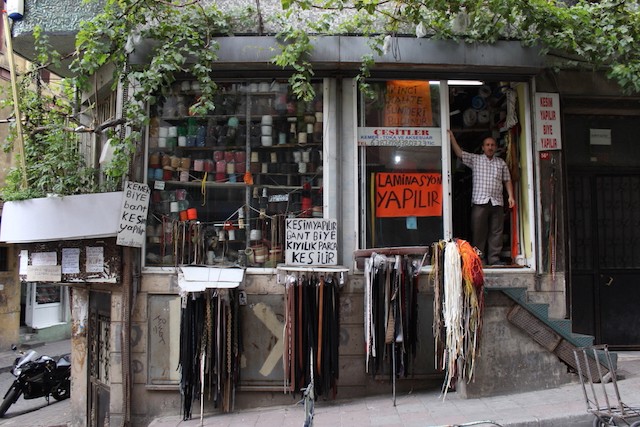
Shoelaces.
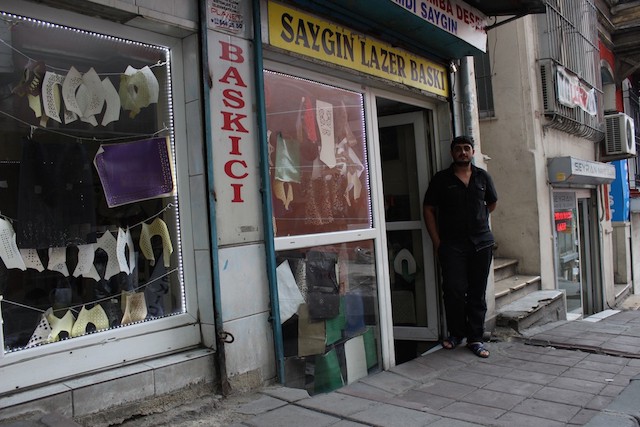
Saygin Lazer Baski, or “respected laser printer.”
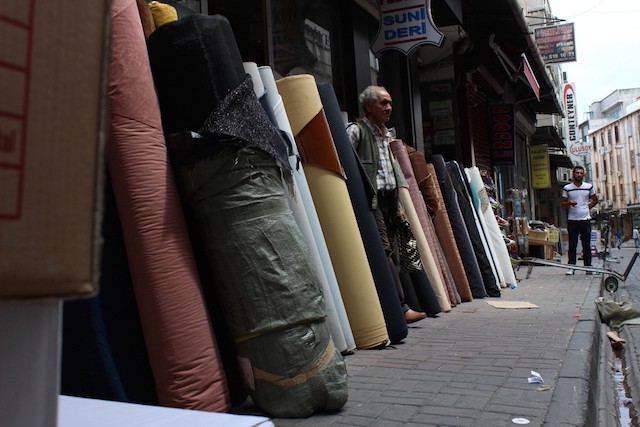
Closer to Tiyatro Cadessi, which runs parallel to Gedikpaşa, deri shops dominated.
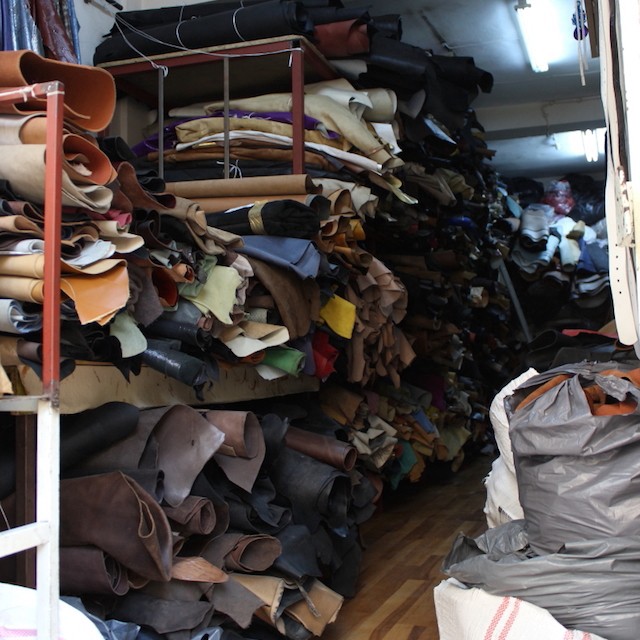
Literally, deri means “leather” or “hide,” but within the district it seems to be used more generally, by sellers of leather, fur, fabric, textiles, any of the natural or synthetic “soft” materials used for a shoe’s upper.
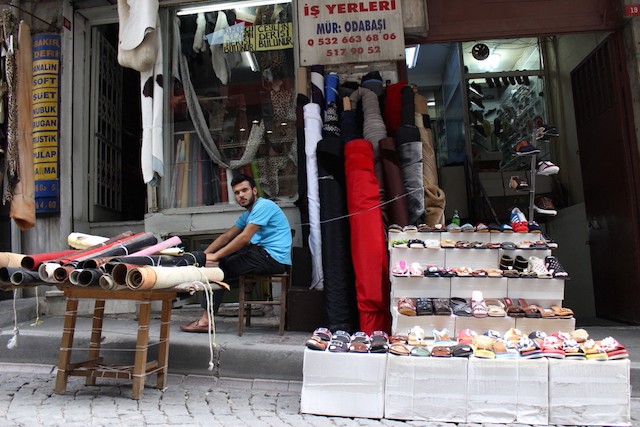
The supply shops were almost always empty; shopkeepers stationed themselves on the sidewalk out front. Sometimes they congregated in groups of two or three in front of one shop, while other shops were left entirely unattended.
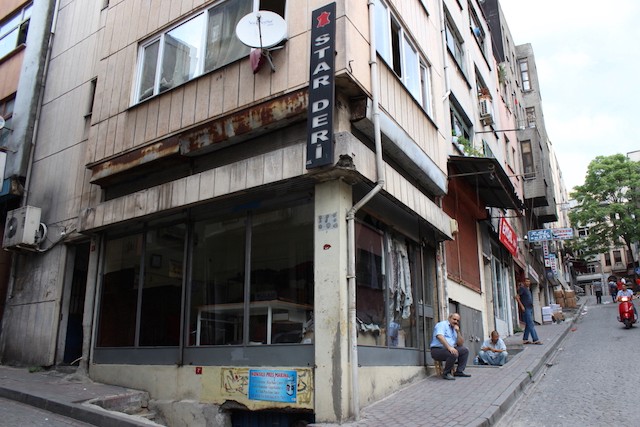
The proprietor of Star Deri and I got to talking on account of the kittens just across the street from his shop. If cats occupy the private sphere in New York City, they’re very much part of public life in Istanbul, where they are legion.
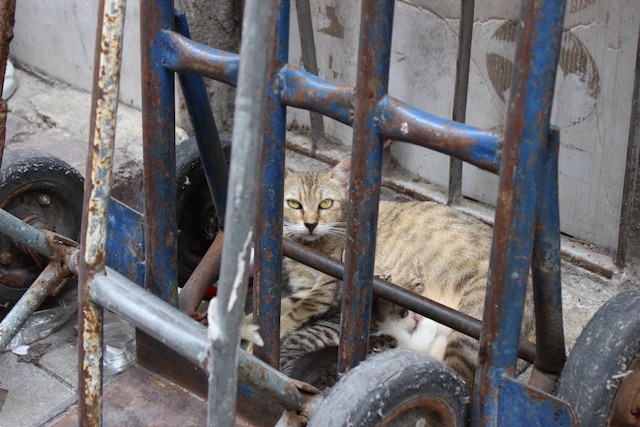
They were nobody’s cats and everybody’s cats. Everywhere, people provided makeshift shelters for them, put out food, kept water bowls (usually fashioned from the bottom half of a plastic liter bottle) filled to the brim.
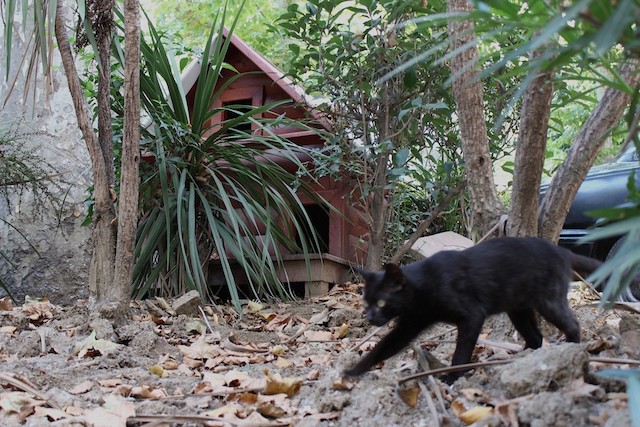
I even found a sturdy cat chalet within a small median of shrubs and trees along one street. “Fatih Belyedesi,” the name of the local municipality government, was stenciled on its side.
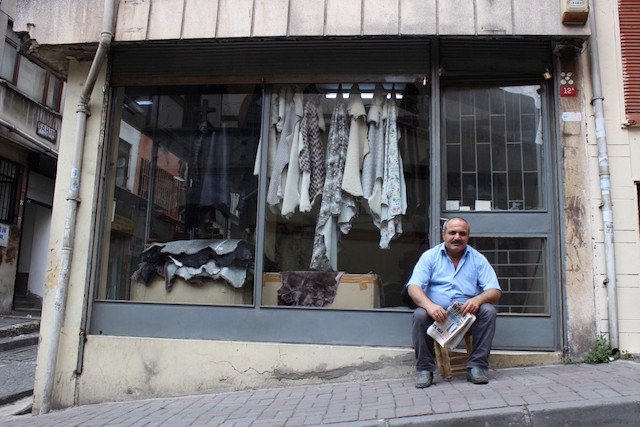
After taking a few pictures of the kittens, I turned toward the proprietor of Star Deri (I never did get his name) and gestured with my camera to see if he would mind my taking a photo of him and his shop.
“Mama” he said, tilting his head just a little bit toward the sky, and saying a few words in Turkish.
“Their mama?”
“Mama,” he said again, drawing a finger across his throat, just to be clear. “I feed them,” he said, lifting up a baby bottle that must’ve been tucked under his stool.
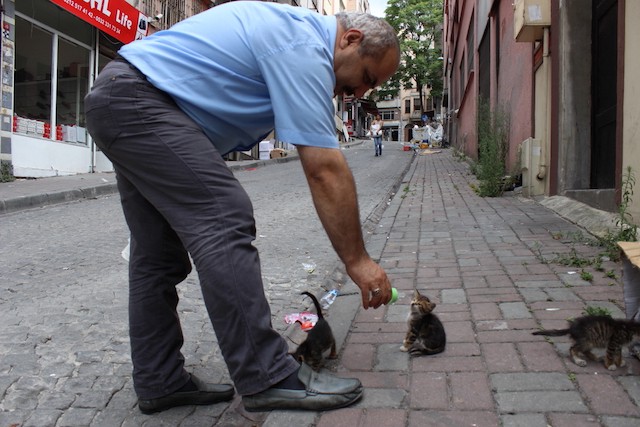
The kittens cared for, he invited me into his shop to look at his wares. One by one, he picked out samples for me and identified them. “Syrian leather” he’d say, pausing to make sure I understood. “From Syria.” Then, reaching for another sample, “Australian fur.” We nodded. “For boot.”
“For boot?”
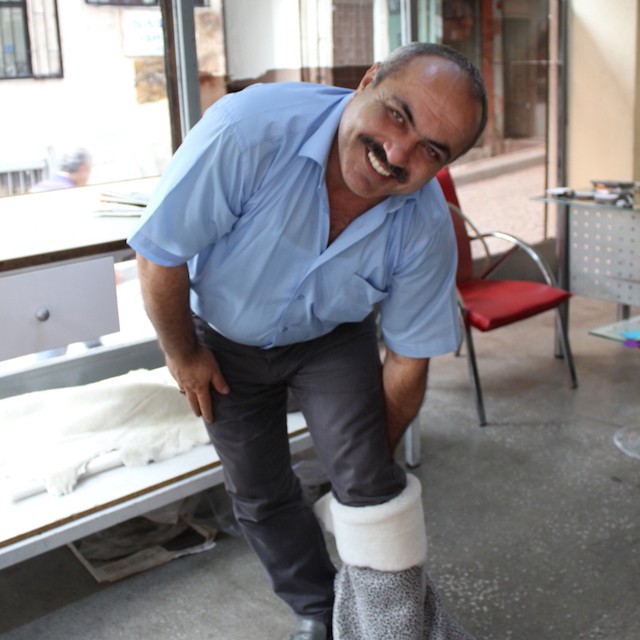
With a deft, practiced motion he wrapped the sample around his shin. “Like Uggs,” I said.
“Like Uggs,” he repeated back to me.
“Egyptian leather,” he said, moving right along.
The Wholesalers

Further yet uphill, above the workshops, above the supply houses, were the showrooms. Surveying a single bystreet branching off Gedikpaşa I could see twenty or more of them, one next to the other. Along a few short blocks, there couldn’t have been less than a hundred.
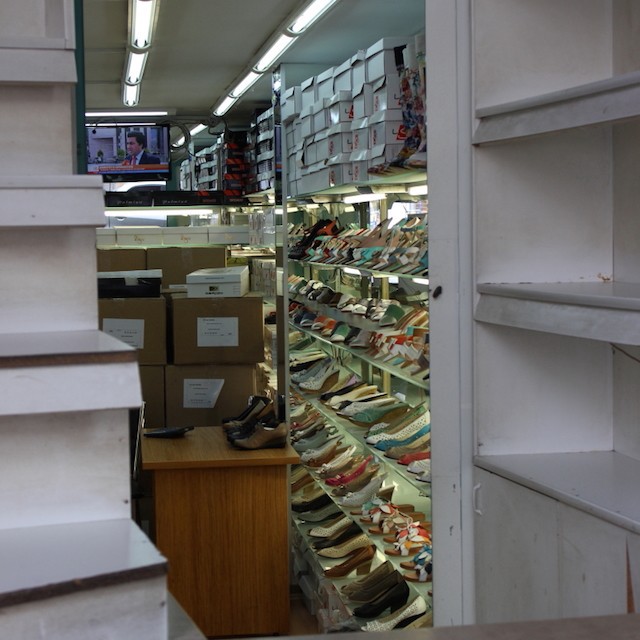
These showrooms, I eventually realized, had no low seats for customers, no mirrors, no accommodations for trying on shoes.
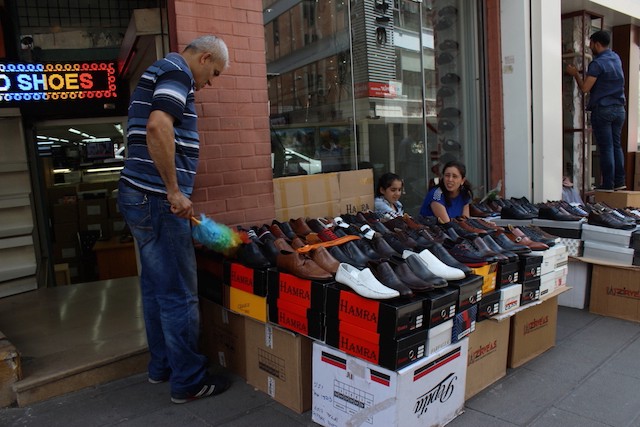
Here, signage was occasionally in English, for the convenience of foreign buyers, I suppose. For the same reason, the dealers seemed more likely to speak English, though a few conversations began and ended with admonishments not to take any pictures.
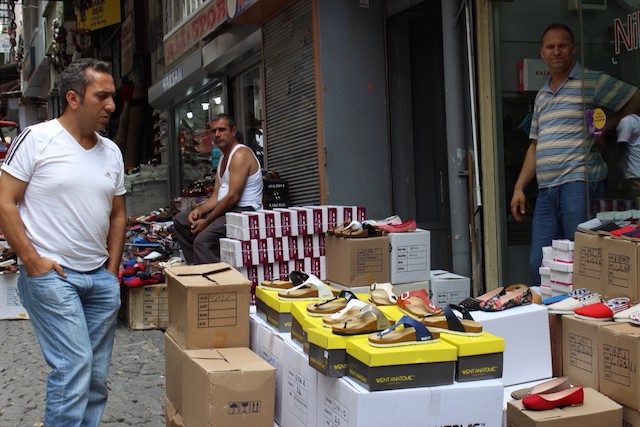
At first I attributed this to the dubious name-brand merchandise I spotted in front of a few showrooms, but I came to think that their reticence illustrated a different mindset: whereas the shoemakers and suppliers saw no harm in my poking around, and enjoyed the interruption, the dealers, or at least some of them, calculating in a different fashion, saw no profit and sent me on my way.

One young shopkeeper asked me where I came from. I told him. “Michael Jackson, you know Michael Jackson,” he said.
“Yes, of course, Michael Jackson,” I said, a little bit unsure whether he meant personally.
He extended his right arm. “I do it myself. In military,” he said.
I was so surprised that I didn’t manage to ask the question foremost in my mind, Why? I nodded admiringly.
“And the other tattoo?” I asked, breaking a silence that had gone on a bit too long.
He touched his index and middle fingers to his heart, as if tracing the outlines of the letters.
“I was 18… in love.”
“It’s her name, her initials?”
He nodded.
“We were … for a few years.”
I nodded again, sympathetically.
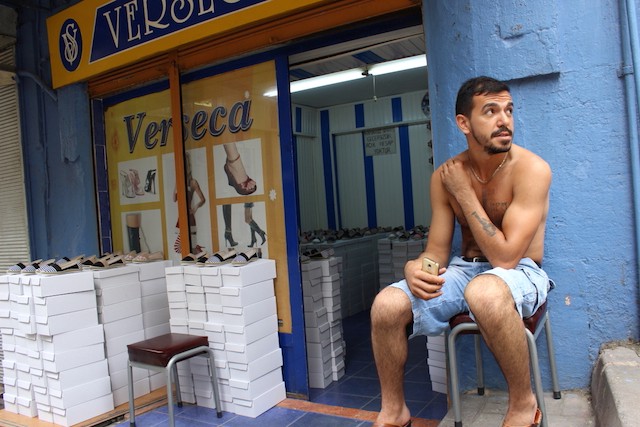
At that point, another young man appeared on the scene. MJ (as I had dubbed the tattooed dealer) introduced the newcomer as Ali, a Turk from Syria who had recently emigrated here for work. After the two exchanged some pleasantries in Turkish, MJ’s associate removed a leather shoe, a loafer, from a shoebox he was carrying and handed it to MJ. Turning a trained eye to the task, MJ flipped it over to check the sole and gave the upper a quick tug. He handed it back, allowed himself a brief, judicious pause and gave his associate the most noncommittal of shrugs.
I couldn’t tell whether he was being asked to buy the shoe or give an unbiased opinion. But I did get a glimpse of how business could be conducted. I saw that orders large and small — for loafers, for bolts of Syrian leather, for cases of rubber cement — could be placed with just a few words out on the street, in passing or over a cup of tea. The wholesalers and suppliers knew each other and they knew the merchandise — they hardly needed to go inside their shops to conduct business. They could afford to sit out on the street, where the action was.
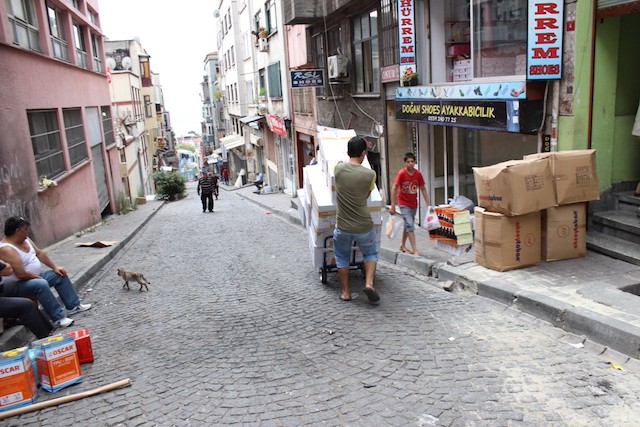
According to a 2009 analysis of the footwear industry published by the Export Promotion Center of Turkey, there are 4,753 footwear manufacturers in Turkey, employing a total of 26,954 shoemakers (more or less). The 33 leading companies account for about half of Turkey’s shoe production, which, according to the 2011 World Footwear Yearbook , was 174 million pairs, of which 72 million pairs were for export, primarily to Iraq, Saudi Arabia, and Russia.
One day, near my flat, I struck up a conversation with a man who lived in the neighborhood — one of the few I met who spoke fluent English. He was not involved in the footwear trade (he worked in a hotel, on the “new” side of the city, capitalizing, I suppose, on his language skills), but he told me that the shoemakers of Gedikpaşa are renowned for their smoking and drinking, for doing as they please and generally not taking very good care of themselves. “By the time they’re forty,” he said, “they look old — they are old.”
The government, he went on, had facilitated the development of large-scale modern shoe factories, but many of the shoemakers refused to uproot, and continued on in their workshops as they had always done. This is confirmed by that report: “Especially in the 1980s, significant investments in machinery parks were made,” it happily states, “and now over 15% of the sector has completed its industrialization process, about 70% of the production in the sector is carried out by semi-mechanized production processes and almost 15% of production is hand-made.”
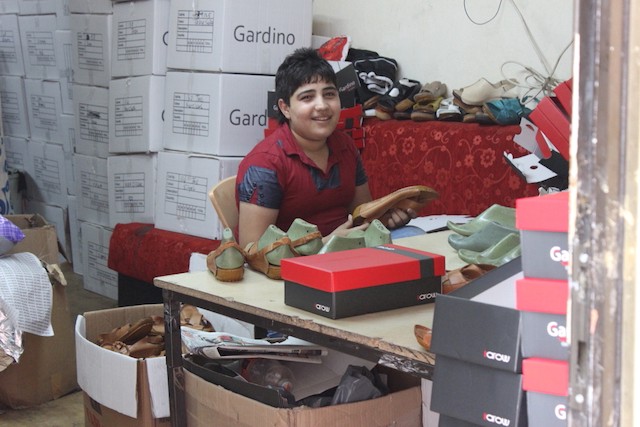
Why did they prefer to stay, I asked? “The discipline of the factory,” he said. “No smoking in the factory. You have to show up. You have to sit. There’s no doing the way you want.”
Erich Strom is a freelance writer and editor living in Astoria.
Travis Scott, "Quintana Pt. 2"
“THIS IS NOT A MIXTAPE FREE ALBUM AND VIDEO FOR THE KIDS,” tweeted Travis Scott after posting the sprawling, guest-packed Days Before Rodeo in full. You can stream it here; listen in the track above for an uncredited guest from T.I.
